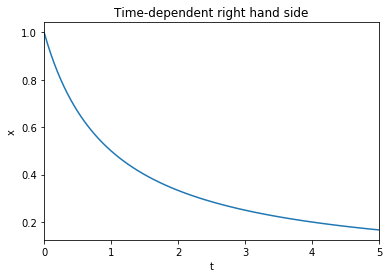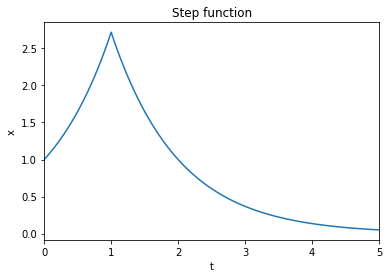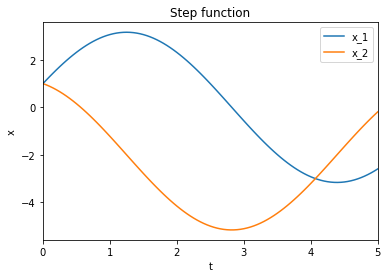Toy Examples of Format Features
This notebook demonstrates minimal examples of the following format features:
Time-dependent right hand sides
Step functions in the right hand side
Function definitions
Time-dependent right hand side:
time_dependent_rhs.yml implements the ODE
via
time:
variable: t
odes:
- stateId: x
rightHandSide: -x/(t+1)
initialValue: 1
The time variable t needs to be defined.
[1]:
import yaml2sbml
yaml_file_basic = 'time_dependent_rhs.yml'
sbml_output_file = 'time_dependent_rhs.xml'
yaml2sbml.yaml2sbml(yaml_file_basic, sbml_output_file)
For the sake of brevity, simulation and plotting is done in a separate function. Details on these steps can be found in other notebooks.
[2]:
%matplotlib inline
from simulation_and_plotting import simulate_AMICI, plot_AMICI
import amici.plotting
#simulate
amici_model, rdata = simulate_AMICI(sbml_output_file)
#plot
plot_AMICI(amici_model, rdata, 'Time-dependent right hand side')

Step functions in the right hand side
step_function.yml implements the ODE
via
time:
variable: t
odes:
- stateId: x
rightHandSide: piecewise(x, t < 1, -x)
initialValue: 1
More details on piecewise functions can be found in the libsbml documentation.
[3]:
import yaml2sbml
yaml_file_basic = 'step_function.yml'
sbml_output_file = 'step_function.xml'
# translate yaml file to sbml
yaml2sbml.yaml2sbml(yaml_file_basic, sbml_output_file)
As discussed above, we plot via:
[4]:
%matplotlib inline
#simulate
amici_model, rdata = simulate_AMICI(sbml_output_file)
#plot
plot_AMICI(amici_model, rdata, 'Step function')

Function definition
yaml2sbml allows to define functions, that can then be called in other parts of the model. functions_in_rhs.yaml implements the ODE
where \(f(x, a, b) = a \cdot x + b\) via
odes:
- stateId: x_1
rightHandSide: f(x_2, 1, 2)
initialValue: 1
- stateId: x_2
rightHandSide: f(x_1, -1, 0)
initialValue: 1
functions:
- functionId: f
arguments: x, a, b
formula: a * x + b
[6]:
import yaml2sbml
yaml_file_basic = 'functions_in_rhs.yml'
sbml_output_file = 'functions_in_rhs.xml'
# translate yaml file to sbml
yaml2sbml.yaml2sbml(yaml_file_basic, sbml_output_file)
We now follow the usual work flow for simulation and plotting.
[7]:
%matplotlib inline
#simulate
amici_model, rdata = simulate_AMICI(sbml_output_file)
#plot
plot_AMICI(amici_model, rdata, 'Step function')
